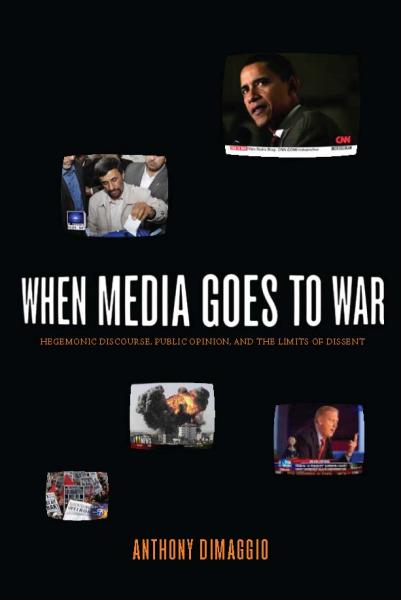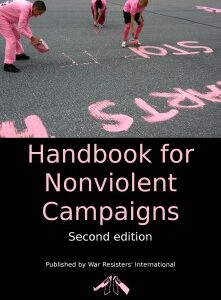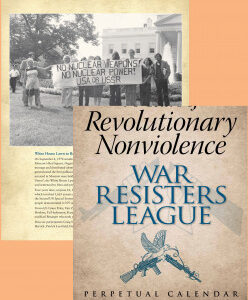The Medium Is the Message: The News Is Propaganda

When Media Goes to War:
Hegemonic Discourse, Public Opinion, and the Limits of Dissent
By Anthony Dimaggio
Monthly Review Press, 2009, 376 pages, $18.95
The media blitz following the Israeli raid on the Mavi Marmara, one of the ships in the aid flotilla attempting to break the Israeli blockade of Gaza this summer, showed us how important accurate information, reporting dissenting opinions, and public perceptions of international news are in achieving peace and justice in a violent and militaristic age. The Israeli government immediately painted Palestinian solidarity activists, of whom Israeli commandos killed nine aboard the Mavi Marmara, as terrorists and Hamas sympathizers. Most media accounts framed the event as one in which the activists threatened Israeli security, violated the Israeli blockade, and shot first when Israeli forces boarded the ship. However, few journalists raised the issue of how Palestinian security is threatened by the illegal blockade of Gaza and how the goal of the activists was not only to deliver humanitarian aid to Gazans but to engage in an act of civil disobedience on their behalf. Rather than featuring interviews with the flotilla organizers, or perhaps some Gazans suffering under the economic embargo, media discourse in early June was dominated by government spokespersons from Israel, Turkey, the Palestinian Authority, and the United States. Official sources emphasized the diplomatic repercussions of the event rather than the reason aid ships were travelling to Gaza in the first place. Sadly, this version of reporting international news in which the press relies almost exclusively on official sources is pervasive throughout U.S. newsrooms.
It is this sad but prevailing version of international news that author Anthony DiMaggio methodically critiques in his book When Media Goes to War. DiMaggio examines press coverage of U.S. foreign relations, including plans for U.S. withdrawal from Iraq, Iran’s alleged nuclear weapons development, and public opinion of U.S. wars in the Middle East. Presenting an in-depth content analysis, the author concludes that much of the international news reported by major media outlets is de facto government propaganda. Mainstream journalists’ heavy reliance on government officials, military officers, and other political and economic elites results in reporting that mirrors U.S. government foreign policy positions. DiMaggio cites one study that revealed official sources “reach as high as 78 percent of all sources quoted in papers like the New York Times and Washington Post.”
After reviewing Antonio Gramsci’s concept of hegemony and Edward Herman and Noam Chomsky’s central thesis outlined in Manufacturing Consent: The Political Economy of the Mass Media, DiMaggio dissects foreign affairs stories of major U.S. and British newspapers and television news programs, which maintain a pro-government bias that remains largely invisible because it is considered the journalistic norm. Political debate as portrayed in the media is limited to the difference between one party’s views and the other’s. Moral and ethical challenges to war are left by the wayside and replaced by so-called dissenting views, which only criticize the effectiveness of a given war strategy, rather than the Afghanistan or Iraq War overall, or war in general.
While criticizing the failure of U.S. journalists to cover U.S. foreign policy from angles outside the framework of the two-party system, DiMaggio goes into a deeper analysis of how coverage of international issues is skewed toward the official U.S. government viewpoint. In reporting on U.S.-Iranian relations and nuclear development, journalists regularly cite Iran’s nuclear program and the dangers of an Iran armed with nuclear weapons. However, they fail to acknowledge the full extent of the U.S. nuclear weapons program and the fact that the International Atomic Energy Agency and U.S. intelligence agencies have repeatedly found no evidence of an Iranian nuclear weapons program. DiMaggio notes the media’s uncritical parroting of fear-mongering rhetoric against Iran and its alleged nuclear weapons program, comparing it with the media’s failure to adequately investigate Bush administration claims of weapons of mass destruction in Iraq prior to the U.S. invasion. He writes, “It seems that reporters learned little from the Iraq debacle, in which a similar deference to official misinformation greatly harmed journalists’ credibility.” While it is scary to contemplate yet another nation developing nukes, in addition to the nine nuclear powers, it is important to note the hypocrisy in U.S. news, which demonizes Iran for a remote potentiality without critically reporting on the nuclear weapons programs of the United States and its nuclear-armed allies, which continue to add to their stockpiles in violation of the Nuclear Non-Proliferation Treaty. DiMaggio makes the double standard clear, arguing that a more critical tone from journalists is not only fair but necessary when reporting on the nuclear weapons development plans of permanent member states of the U.N. Security Council.
DiMaggio’s critical study of reporting on Iraq effectively undermines the myth of objective journalism while showing its dangers by comparing U.S. reporting with British reporting, which offers a higher degree of journalist commentary within traditional news reporting. The author’s use of statistics and graphical representations helps the reader visualize the disjuncture between U.S. news coverage based on elite sources and the views of the general public. Throughout the book, DiMaggio asks why the voice of the public, whether a U.S. antiwar protester, an Iraqi living under U.S. occupation, or the public at large, remains absent from U.S. news reports when the free press is supposed to provide citizens with a diverse range of political views in order to sustain a fair and just democracy. “In a democracy, it is the public’s opposition, not opposition from adversarial political officials, that represents the most important component of dissent,” he writes. “When the people’s moral challenges to U.S. power are systematically cut out of media reporting … media become little more than lapdogs of the state.” Example after example of U.S. news stories on the Iraq War from the past decade shows that when it comes to reporting on U.S. wars abroad, the U.S. press is more chihuahua than doberman.
Little Changed
In his postscript, DiMaggio claims that media coverage of the U.S. wars abroad has changed little under the Obama administration. As we saw when WikiLeaks.org released the Afghan War Diary, the media continue to criticize the strategy of the U.S. military in Afghanistan and Iraq, questioning whether the wars are winnable, but failing to include antiwar voices in the commentary. What is missing from DiMaggio’s account of media coverage of some of the most important international issues of the modern era is an examination of the press in the Middle East and global media coverage of the Arab-Israeli conflict, especially the 2008−09 Israeli assault on Gaza. In addition, while the author remains highly critical of the media, editors, and journalists, he glosses over the causes of the declining quality of news reporting, especially international news: corporate media’s reliance on advertising revenues, which have shrunk as media technologies evolve, platforms continue to converge, and the U.S. economy flounders. These developments have left news outlets with fewer foreign bureaus and correspondents and smaller budgets, one reason newspapers and broadcast news programs rely more often on news wires, government press releases, and each other rather than sending their own reporters out into the world. For a detailed discussion of the state of the modern news industry and a controversial but extremely plausible policy that could save independent news and U.S. democracy, see Robert McChesney and John Nichols’ The Death and Life of American Journalism. Journalism is in trouble, but if citizens recognize that they are losing their last, best hope to stay informed, we could act to create viable, hard-hitting international news operations.
Near the end of the book, DiMaggio writes, “The goal of activists is always to ensure that skeptical Americans follow the active path, rather than falling into complacency and ignorance.” The goal of journalists is similar, and in this sense, despite the myth of objectivity in reporting, journalists are, or at least should be, activists. Israel has agreed to cooperate with a U.N. investigation into the incident aboard the Mavi Marmara. Hopefully, the truth will come to light, whether Israeli forces or a few activists attacked first. More important, citizens of the world will read, hear, and see the facts surrounding the nonviolent action that turned violent, and with truthful reporting and critical journalists as their guides, ensure that elected officials act appropriately, and if not, continue sending ships packed with activists and reporters to Gaza until the blockade is broken.

 Handbook for Nonviolent Campaigns, 2nd Edition
Handbook for Nonviolent Campaigns, 2nd Edition  WRL Perpetual Calendar
WRL Perpetual Calendar